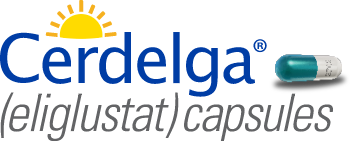Gaucher Disease Is a Rare Genetic Disorder That Causes GL-1 Accumulation1
Gaucher disease is caused by a deficiency of the lysosomal enzyme beta-glucosidase. The enzymatic deficiency causes an accumulation of glucosylceramide (GL-1) in the lysosomes.1,2
GL-1 accumulation in cells of the liver, spleen, and bone marrow leads to progressive multiorgan dysfunction. Gaucher disease type 1 can be managed effectively once diagnosed.1,2
Gaucher Disease Is Inherited Through an Autosomal Recessive Pattern3
Gaucher disease usually occurs when an individual inherits 2 pathogenic variants within the GBA1 gene, one from each parent.4,5 The disease can be passed down to children in the following ways4:

When both parents are carriers, there is*:
• A 50% (1 in 2) chance of a child also being a carrier
• A 25% (1 in 4) chance that a child will have Gaucher disease
• A 25% (1 in 4) chance that a child will be unaffected
When one parent is a carrier and one is unaffected, there is*:
• A 50% (1 in 2) chance of a child being a carrier
• A 50% (1 in 2) chance of a child being unaffected
When one parent has Gaucher disease and one is unaffected, there is*:
• A 100% chance of a child being a carrier
When one parent has Gaucher disease and one is a carrier, there is*:
• A 50% (1 in 2) chance a child will have Gaucher disease
• A 50% (1 in 2) chance of a child being a carrier
*The probability of having a child with Gaucher disease type 1 does not change, no matter how many children the parents have.
In most cases, both parents must carry a pathogenic variant in the GBA1 gene to have an affected child. Males and females are affected equally.4
Gaucher Disease Type 1 Is More Prevalent Than You Think
More than 90% of patients with Gaucher disease in the United States are type 1.2 Although Gaucher disease type 1 is a rare genetic condition, it's important to understand its occurrence in different patient populations.
ESTIMATED PREVALENCE OF GAUCHER DISEASE TYPE3,6
~1 in 40,000
Pan-ethnic and occurs in ~1 in 40,000 in the general population
~1 in 850
Occurs in ~1 in 850 people of Ashkenazi Jewish heritage
~90%
~90% of Jewish Americans are of Ashkenazi Jewish heritage

- In people of Ashkenazi Jewish heritage, Gaucher disease type 1 has a higher incidence (~1 in 850) than hematologic malignancies (~1 in 2500)2
- For individuals of Ashkenazi Jewish heritage, ~1 in 12 is a carrier of Gaucher disease3
Ready to SWITCH eligible adult patients to Cerdelga?
Cerdelga was proven noninferior to ERT1
Curious about the Cerdelga mechanism of action?
See how Cerdelga works to reduce GL-1 production.7
Indication and Usage
CERDELGA is indicated for the long-term treatment of adult patients with Gaucher disease type 1 (GD1) who are CYP2D6 extensive metabolizers (EMs), intermediate metabolizers (IMs), or poor metabolizers (PMs) as detected by an FDA-cleared test.
Limitations of Use:
- Patients who are CYP2D6 ultra-rapid metabolizers (URMs) may not achieve adequate concentrations of CERDELGA to achieve a therapeutic effect.
- A specific dosage cannot be recommended for those patients whose CYP2D6 genotype cannot be determined (indeterminate metabolizers).
Important Safety Information
CONTRAINDICATIONS
CERDELGA is contraindicated in the following patients based on CYP2D6 metabolizer status due to the risk of cardiac arrhythmias from prolongation of the PR, QTc, and/or QRS cardiac intervals:
- Extensive Metabolizers (EMs) taking a strong or moderate CYP2D6 inhibitor concomitantly with a strong or moderate CYP3A inhibitor, EMs with moderate or severe hepatic impairment, or EMs with mild hepatic impairment and taking a strong or moderate CYP2D6 inhibitor.
- Intermediate Metabolizers (IMs) taking a strong or moderate CYP2D6 inhibitor concomitantly with a strong or moderate CYP3A inhibitor, IMs taking a strong CYP3A inhibitor, or IMs with any degree of hepatic impairment.
- Poor Metabolizers (PMs) taking a strong CYP3A inhibitor, or PMs with any degree of hepatic impairment.
WARNINGS AND PRECAUTIONS
CERDELGA is predicted to cause increases in ECG intervals (PR, QTc, and QRS) at substantially elevated plasma concentrations and may increase risk of cardiac arrhythmias. Use of CERDELGA is contraindicated, to be avoided, or requires dosage adjustment in patients taking CYP2D6 or CYP3A inhibitors, depending on CYP2D6 metabolizer status, type of inhibitor, or degree of hepatic impairment. Avoid use of CERDELGA in patients with pre-existing cardiac disease, long QT syndrome, or in combination with Class IA or Class III antiarrhythmic medications.
ADVERSE REACTIONS
The most common adverse reactions (≥10%) to CERDELGA include: fatigue, headache, nausea, diarrhea, back pain, pain in extremities, and upper abdominal pain.
DRUG INTERACTIONS
Coadministration of CERDELGA with CYP2D6 or CYP3A inhibitors may increase eliglustat concentrations, which may increase the risk of cardiac arrhythmias from prolongations of the PR, QTc, and/or QRS cardiac interval. Use of CERDELGA is contraindicated, to be avoided, or may require dosage adjustment depending on the concomitant drug and CYP2D6 metabolizer status. See section 7 of the full Prescribing Information for more details and other potentially significant drug interactions.
USE IN SPECIFIC POPULATIONS
Available data on the use of CERDELGA in pregnant women is not sufficient to assess drug-associated risks of major birth defects, miscarriage, or adverse maternal or fetal outcomes. The developmental and health benefits of breastfeeding should be considered along with the mother’s clinical need for CERDELGA and any potential adverse effects on the breastfed child from CERDELGA or from the underlying maternal condition.
Use of CERDELGA in patients with renal impairment is based on the patient’s CYP2D6 metabolizer status. Avoid use of CERDELGA in EMs with end-stage renal disease (ESRD), and IMs and PMs with any degree of renal impairment.
Use of CERDELGA is contraindicated or may require dosage adjustment in patients with hepatic impairment based on CYP2D6 metabolizer status, concomitant use of CYP2D6 or CYP3A inhibitors, and degree of hepatic impairment.
Please see accompanying full Prescribing Information.
References: 1. Mistry PK, Sadan S, Yang R, et al. Consequences of diagnostic delays in type 1 Gaucher disease: the need for greater awareness among hematologists–oncologists and an opportunity for early diagnosis and intervention. Am J Hematol. 2007;82(8):697-701. 2. Mistry PK, Cappellini MD, Lukina E, et al. A reappraisal of Gaucher disease-diagnosis and disease management algorithms. Am J Hematol. 2011;86(1):110-115. 3. Mistry PK, Weinthal JA, Weinreb NJ. Disease state awareness in Gaucher disease: a Q&A expert roundtable discussion. Clin Adv Hematol Onc. 2012;10(6 Suppl 8):1-16. 4. National Organization for Rare Disorders. Gaucher Disease. Published January 2006. Accessed November 14, 2022. https://rarediseases.org/rare-diseases/gaucher-disease. 5. Mehta A, Belmatoug N, Bembi B, et al. Exploring the patient journey to diagnosis of Gaucher disease from the perspective of 212 patients with Gaucher disease and 16 Gaucher expert physicians. Mol Gen Metab. 2017;122(3):122-129. 6. Memorial Sloan Kettering Cancer Center. More Ashkenazi Jews have gene defect that raises inherited breast cancer risk. The Oncologist News Bulletin. 1996;1:335. 7. Scott LJ. Eliglustat: a review in Gaucher disease type 1. Drugs. 2015;75(14):1669-1678.
Indication and Usage
CERDELGA is indicated for the long-term treatment of adult patients with Gaucher disease type 1 (GD1) who are CYP2D6 extensive metabolizers (EMs), intermediate metabolizers (IMs), or poor metabolizers (PMs) as detected by an FDA-cleared test.
Limitations of Use:
- Patients who are CYP2D6 ultra-rapid metabolizers (URMs) may not achieve adequate concentrations of CERDELGA to achieve a therapeutic effect.
- A specific dosage cannot be recommended for those patients whose CYP2D6 genotype cannot be determined (indeterminate metabolizers).
Important Safety Information
CONTRAINDICATIONS
CERDELGA is contraindicated in the following patients based on CYP2D6 metabolizer status due to the risk of cardiac arrhythmias from prolongation of the PR, QTc, and/or QRS cardiac intervals:
- Extensive Metabolizers (EMs) taking a strong or moderate CYP2D6 inhibitor concomitantly with a strong or moderate CYP3A inhibitor, EMs with moderate or severe hepatic impairment, or EMs with mild hepatic impairment and taking a strong or moderate CYP2D6 inhibitor.
- Intermediate Metabolizers (IMs) taking a strong or moderate CYP2D6 inhibitor concomitantly with a strong or moderate CYP3A inhibitor, IMs taking a strong CYP3A inhibitor, or IMs with any degree of hepatic impairment.
- Poor Metabolizers (PMs) taking a strong CYP3A inhibitor, or PMs with any degree of hepatic impairment.
WARNINGS AND PRECAUTIONS
CERDELGA is predicted to cause increases in ECG intervals (PR, QTc, and QRS) at substantially elevated plasma concentrations and may increase risk of cardiac arrhythmias. Use of CERDELGA is contraindicated, to be avoided, or requires dosage adjustment in patients taking CYP2D6 or CYP3A inhibitors, depending on CYP2D6 metabolizer status, type of inhibitor, or degree of hepatic impairment. Avoid use of CERDELGA in patients with pre-existing cardiac disease, long QT syndrome, or in combination with Class IA or Class III antiarrhythmic medications.
ADVERSE REACTIONS
The most common adverse reactions (≥10%) to CERDELGA include: fatigue, headache, nausea, diarrhea, back pain, pain in extremities, and upper abdominal pain.
DRUG INTERACTIONS
Coadministration of CERDELGA with CYP2D6 or CYP3A inhibitors may increase eliglustat concentrations, which may increase the risk of cardiac arrhythmias from prolongations of the PR, QTc, and/or QRS cardiac interval. Use of CERDELGA is contraindicated, to be avoided, or may require dosage adjustment depending on the concomitant drug and CYP2D6 metabolizer status. See section 7 of the full Prescribing Information for more details and other potentially significant drug interactions.
USE IN SPECIFIC POPULATIONS
Available data on the use of CERDELGA in pregnant women is not sufficient to assess drug-associated risks of major birth defects, miscarriage, or adverse maternal or fetal outcomes. The developmental and health benefits of breastfeeding should be considered along with the mother’s clinical need for CERDELGA and any potential adverse effects on the breastfed child from CERDELGA or from the underlying maternal condition.
Use of CERDELGA in patients with renal impairment is based on the patient’s CYP2D6 metabolizer status. Avoid use of CERDELGA in EMs with end-stage renal disease (ESRD), and IMs and PMs with any degree of renal impairment.
Use of CERDELGA is contraindicated or may require dosage adjustment in patients with hepatic impairment based on CYP2D6 metabolizer status, concomitant use of CYP2D6 or CYP3A inhibitors, and degree of hepatic impairment.
Please see accompanying full Prescribing Information.
References: 1. Mistry PK, Sadan S, Yang R, et al. Consequences of diagnostic delays in type 1 Gaucher disease: the need for greater awareness among hematologists–oncologists and an opportunity for early diagnosis and intervention. Am J Hematol. 2007;82(8):697-701. 2. Mistry PK, Cappellini MD, Lukina E, et al. A reappraisal of Gaucher disease-diagnosis and disease management algorithms. Am J Hematol. 2011;86(1):110-115. 3. Mistry PK, Weinthal JA, Weinreb NJ. Disease state awareness in Gaucher disease: a Q&A expert roundtable discussion. Clin Adv Hematol Onc. 2012;10(6 Suppl 8):1-16. 4. National Organization for Rare Disorders. Gaucher Disease. Published January 2006. Accessed November 14, 2022. https://rarediseases.org/rare-diseases/gaucher-disease. 5. Mehta A, Belmatoug N, Bembi B, et al. Exploring the patient journey to diagnosis of Gaucher disease from the perspective of 212 patients with Gaucher disease and 16 Gaucher expert physicians. Mol Gen Metab. 2017;122(3):122-129. 6. Memorial Sloan Kettering Cancer Center. More Ashkenazi Jews have gene defect that raises inherited breast cancer risk. The Oncologist News Bulletin. 1996;1:335. 7. Scott LJ. Eliglustat: a review in Gaucher disease type 1. Drugs. 2015;75(14):1669-1678.

